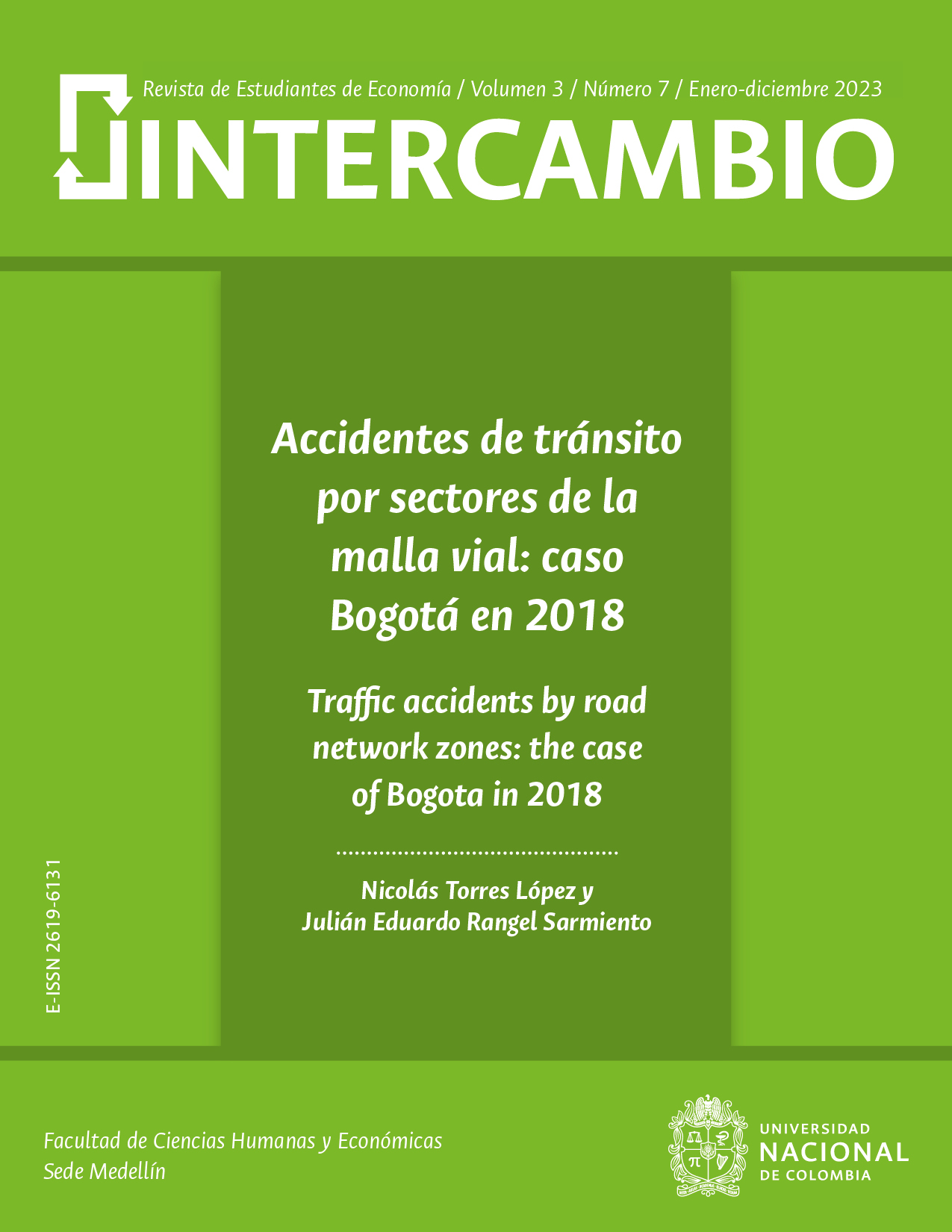Traffic accidents by road network zones: the case of Bogota in 2018
Keywords:
traffic accidents, transportation externalities, logit, Latin AmericAbstract
In this study, various administrative data sets are merged to estimate the determinants of the probabilities of traffic accidents in specific locations of Bogotá’s Road Network in 2018. It is found that: (i) the distance to the nearest traffic light and the number of lanes does not have a significant effect on the location of accidents in the north of Bogotá; (ii) accidents are less likely to occur when the distance to TransMilenio stations increases. In addition, high-speed accidents are more likely in the north, especially on the road sections. Policy makers are urged to consider long-term strategies to mitigate the negative externalities of transportation.
References
Aarts, L., & Van Schagen, I. (2006). Driving speed and the risk of road crashes: Areview. Accident Analysis & Prevention, 38(2), 215-224. https://doi.org/10.1016/j.aap.2005.07.004
Abdel-Aty, M. A., & Radwan, A. E. (2000). Modeling traffic accident occurrence and involvement. Accident Analysis & Prevention, 32(5), 633–642. https://doi.org/10.1016/S0001-4575(99)00094-9 3.
Ahmed, M., Khanom, K., Shampa, R. M., & Bari, M. H. (2004). Road traffic accident among motor vehicle drivers in selected high ways. Mymensingh Medical Journal: MMJ, 13(2), 165-168.
Amoh-Gyimah, R., Aidoo, E. N., Akaateba, M. A., & Appiah, S. K. (2017). The effect of natural and built environmental characteristics on pedestrian-vehicle crash severity in Ghana. International journal of injury control and safety promotion, 24(4), 459-468. https://doi.org/10.1080/17457300.2016.1232274
Aziz, H. A., Ukkusuri, S. V., & Hasan, S. (2013). Exploring the determinants of pedestrian–vehicle crash severity in New York City. Accident Analysis & Prevention, 50, 1298-1309. https://doi.org/10.1016/j.aap.2012.09.034
Bagloee, S. A., & Asadi, M. (2016). Crash analysis at intersections in the CBD: A survival analysis model. Transportation Research Part A: Policy and Practice, 94, 558-572. https://doi.org/10.1016/j.tra.2016.10.019
Cabrera-Arnau, C., Prieto Curiel, R., & Bishop, S. R. (2020). Uncovering the behaviour of road accidents in urban areas. Royal Society open science, 7(4),191739. https://doi.org/10.1098/rsos.191739
Campos Villalobos, G., & López Castillo, C. (2008). Patologías mentales derivadas de los accidentes de tránsito. Medicina Legal de Costa Rica, 25(2), 27-34. https://www. scielo.sa.cr/scielo.php?pid=S1409-00152008000200003&script=sci_arttext
Cerwick, D. M., Gkritza, K., Shaheed, M. S., & Hans, Z. (2014). A comparison of the mixed logit and latent class methods for crash severity analysis. Analytic Methods in Accident Research, 3, 11-27. https://doi.org/10.1016/j.amar.2014.09.002
Chen, Z., & Fan, W. D. (2019). A multinomial logit model of pedestrian-vehicle crash severity in North Carolina. International journal of transportation science and technology, 8(1), 43-52. https://doi.org/10.1016/j.ijtst.2018.10.001
Damsere-Derry, J., Ebel, B. E., Mock, C. N., Afukaar, F., & Donkor, P. (2010). Pedestrians’ injury patterns in Ghana. Accident Analysis & Prevention, 42(4), 1080-1088. https://doi.org/10.1016/j.aap.2009.12.016
Danilevičius, A., Bogdevičius, M. (2020). Impact of Road Traffic Accidents on the Dynamics of Traffic Flows. In: Varhelyi, A., Žuraulis, V., Prentkovskis, O. (eds) Vision Zero for Sustainable Road Safety in Baltic Sea Region. VISZERO 2018. Lecture Notes in Intelligent Transportation and Infrastructure. Springer, Cham. https://doi.org/10.1007/978-3-030-22375-5_10
Rus-Mendoza, G., Campos, J., & Nombela, G. (2003). Economía del transporte. Antoni Bosch editor.
Dommes, A., Cavallo, V., Dubuisson, J. B., Tournier, I., & Vienne, F. (2014). Crossing a two-way street: comparison of young and old pedestrians. Journal of safety research, 50, 27-34. https://doi.org/10.1016/j.jsr.2014.03.008
Elvik, R. (2005). Speed and road safety: synthesis of evidence from evaluation studies. Transportation Research Record, 1908(1), 59-69. https://doi. org/10.1177/0361198105190800108
Etehad, H., Yousefzadeh-Chabok, S. H., Davoudi-Kiakalaye, A., Moghadam, D. A., Hemati, H., & Mohtasham-Amiri, Z. (2015). Impact of road traffic accidents on the elderly. Archives of gerontology and geriatrics, 61(3), 489-493. https://doi.org/10.1016/j.archger.2015.08.008
Gomes, S. V. (2013). The influence of the infrastructure characteristics in urban road accidents occurrence. Accident Analysis & Prevention, 60, 289-297. https://doi.org/10.1016/j.aap.2013.02.042
Gómez-Restrepo, C., Quitian, H., Maldonado, P., Naranjo-Lujan, S., Rondón, M.,Acosta, A., ... & Saavedra, M. Á. (2014). Costos directos de atención médica de accidentes de tránsito en Bogotá DC. Revista de Salud Pública, 16, 673 682. http://dx.doi.org/10.15446/rsap.v16n5.44080
Gorea, R. K. (2016). Financial impact of road traffic accidents on the society. International Journal of Ethics, Trauma & Victimology, 2(01), 6-9. https://doi.org/10.18099/ijetv.v2i1.11129
Guzmán, L. A., Oviedo, D., & Bocarejo, J. P. (2016). City profile: the Bogotá metropolitan area that never was. Cities, 60, 202 215. https://doi.org/10.1016/j.cities.2016.09.004
Hakim, S., Shefer, D., Hakkert, A. S., & Hocherman, I. (1991). A critical review of macro models for road accidents. Accident Analysis & Prevention, 23(5), 379-400. https://doi.org/10.1016/0001-4575(91)90058-D
Haleem, K., Alluri, P., & Gan, A. (2015). Analyzing pedestrian crash injury severity at signalized and non-signalized locations. Accident Analysis & Prevention, 81,14-23. https://doi.org/10.1016/j.aap.2015.04.025
Hasanat-E-Rabbi, S., Raihan, M. A., Mahmud, S. S., & Hoque, M. S. (2022). Pedestrian injury outcomes in the developing urban metropolis: Econometric models for assessing risk factors. IATSS research, 46(2), 269-280. https://doi.org/10.1016/j.iatssr.2022.01.002
Herd, D. R., Agent, K. R., & Rizenbergs, R. L. (1980). Traffic accidents: day versus night. Transportation research record, 753, 25-30. http://dx.doi.org/10.13023/KTC.RR.1980.545
Jansson, J. O. (1994). Accident externality charges. Journal of transport Economics and Policy, 31-43. http://www.jstor.org/stable/20053022
Jiménez-Mejías, E., Martínez-Ruiz, V., Amezcua-Prieto, C., Olmedo-Requena, R., de Dios Luna-del-Castillo, J., & Lardelli Claret, P. (2016). Pedestrian-and driver-related factors associated with the risk of causing collisions involving pedestrians in Spain. Accident Analysis & Prevention, 92, 211-218. https://doi.org/10.1016/j.aap.2016.03.021
Li, J., & Zhao, Z. (2022). Impact of COVID-19 travel-restriction policies on road traffic accident patterns with emphasis on cyclists: a case study of New York City. Accident Analysis & Prevention, 167, 106586. https://doi.org/10.1016/j.aap.2022.106586
Li, S., Linn, J., & Muehlegger, E. (2014). Gasoline taxes and consumer behavior. American Economic Journal: Economic Policy, 6(4), 302-342. DOI: 10.1257/pol.6.4.302
Li, Y., & Fan, W. (2020). Modelling the severity of pedestrian injury in pedestrian— vehicle crashes in North Carolina: A partial proportional odds logit model approach. Journal of Transportation Safety & Security, 12(3), 358-379. https://doi.org/10.1080/19439962.2018.1483989
Mangones, S. C., Fischbeck, P., & Jaramillo, P. (2017). Safety-related risk and benefit-cost analysis of crash avoidance systems applied to transit buses: Comparing New York City vs. Bogota, Colombia. Safety science, 91, 122-131. https://doi.org/10.1016/j.ssci.2016.08.003
Masilkova, M. (2017). Health and social consequences of road traffic accidents. Kontakt, 19(1), e43-e47. https://doi.org/10.1016/j.kontakt.2017.01.007
Mayou, R., Bryant, B., & Duthie, R. (1993). Psychiatric consequences of road traffic accidents. British Medical Journal, 307(6905), 647-651. https://doi. org/10.1136/bmj.307.6905.647
Mishan, E. J. (1971). Evaluation of life and limb: a theoretical approach. Journal of Political Economy, 79(4), 687-705. https://www.journals.uchicago.edu/doi/abs/10.1086/259784
Montes, S. A., & Ledesma, R. D. (2021). Estrés postraumático luego de siniestros viales: una revisión sistemática. Terapia psicológica, 39(1), 103-122. http://dx.doi.org/10.4067/S0718-48082021000100103
Mphela, T. (2020). Causes of road accidents in Botswana: An econometric model. Journal of Transport and Supply Chain Management, 14(1), 1-8. https://hdl.handle.net/10520/ejc-jtscm-v14-n1-a14
NHTSA. (2020). Exceso de velocidad. https://www.nhtsa.gov/es/conducir-deforma- riesgosa/exceso-de-velocidad
Organización mundial de la salud. (2021, 21 junio). Traumatismos causados por el tránsito. https://www.who.int/es/news room/fact-sheets/detail/road-traffic-injuries
Parry, I. W. H., Walls, M., & Harrington, W. (2007). Automobile externalities and policies. Journal of economic literature, 45(2), 373-399. DOI: 10.1257/jel.45.2.373
Pour, A. T., Moridpour, S., Tay, R., & Rajabifard, A. (2016). A partial proportional odds model for pedestrian crashes at mid blocks in Melbourne metropolitan area. In MATEC web of conferences (Vol. 81, p. 02020). EDP Sciences. https://doi.org/10.1051/matecconf/20168102020
Pour-Rouholamin, M., & Zhou, H. (2016). Investigating the risk factors associated with pedestrian injury severity in Illinois. Journal of safety research, 57, 9-17. https://doi.org/10.1016/j.jsr.2016.03.004
Rolison, J. J., Regev, S., Moutari, S., & Feeney, A. (2018). What are the factors that contribute to road accidents? An assessment of law enforcement views, ordinary drivers’ opinions, and road accident records. Accident Analysis & Prevention, 115, 11-24. https://doi.org/10.1016/j.aap.2018.02.025
Sagberg, F. (1999). Road accidents caused by drivers falling asleep. Accident Analysis & Prevention, 31(6), 639-649. https://doi.org/10.1016/S0001-4575(99)00023-8
Santos, G., Behrendt, H., Maconi, L., Shirvani, T., & Teytelboym, A. (2010). Part I: Externalities and economic policies in road transport. Research in transportation economics, 28(1), 2-45. https://doi.org/10.1016/j.retrec.2009.11.002
Su, Z., Woodman, R., Smyth, J., & Elliott, M. (2023). The relationship between aggressive driving and driver performance: A systematic review with meta-analysis. Accident Analysis & Prevention, 183, 106972. https://doi.org/10.1016/j.aap.2023.106972
Sun, M., Sun, X., & Shan, D. (2019). Pedestrian crash analysis with latent class clustering method. Accident Analysis & Prevention, 124, 50-57. https://doi.org/10.1016/j.aap.2018.12.016
Theofilatos, A., & Yannis, G. (2014). A review of the effect of traffic and weather characteristics on road safety. Accident Analysis & Prevention, 72, 244-256. https://doi.org/10.1016/j.aap.2014.06.017
Tulu, G. S., Washington, S., Haque, M. M., & King, M. J. (2017). Injury severity of pedestrians involved in road traffic crashes in Addis Ababa, Ethiopia. Journal of Transportation Safety & Security, 9(sup1), 47-66. https://doi.org/10.1080/19439962.2016.1199622
Uddin, M., & Ahmed, F. (2018). Pedestrian injury severity analysis in motor vehicle crashes in Ohio. Safety, 4(2), 20. https://doi.org/10.3390/safety4020020
Zou, X., & Yue, W. L. (2017). A bayesian network approach to causation analysis of road accidents using netica. Journal of advanced transportation, 2017. https://doi.org/10.1155/2017/2525481

Published
How to Cite
Issue
Section
Copyright (c) 2024 Intercambio

This work is licensed under a Creative Commons Attribution-NonCommercial-NoDerivatives 4.0 International License.



